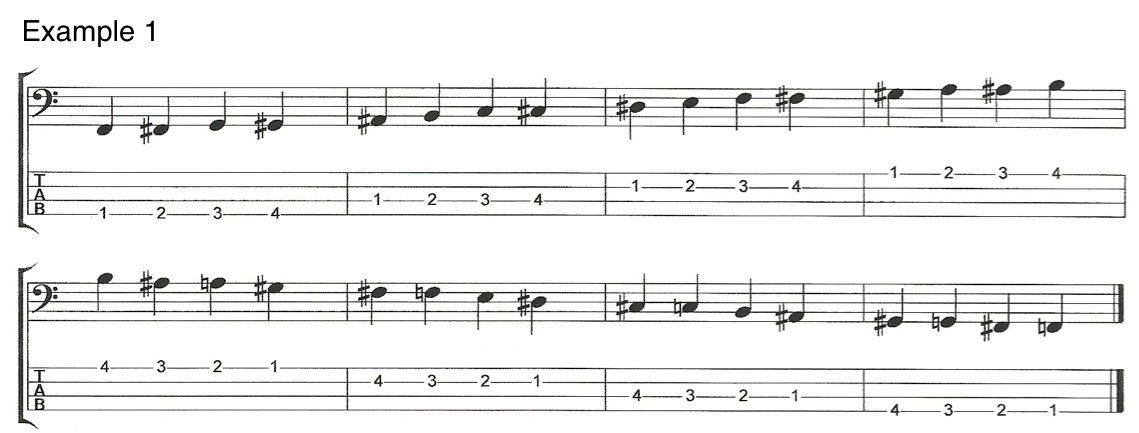Hammer Ons and Pull Offs – Left Hand Technique Lesson – Bass Practice Diary – 27 November 2018
Someone asked me recently to do a video with some Hammer Ons and Pull Offs exercises. I don’t usually do videos based on suggestions, but this time I thought it was a good idea. Because practising Hammer Ons and Pull Offs is a great way to improve your Left Hand Technique.
Having said that, I believe that there are a few basic things that you need to get right if you are going to improve your technique by practicing hammer ons and pull offs.
Left Hand Techniques
The first thing is to come up with exercises that use four fingers on your left hand. If you want to play with good technique in your left hand then you need to be able to play evenly between all of your fingers.
I see so many beginner and intermediate bass players favouring certain fingers and trying to avoid other fingers on their left hand. It’s very natural to play like that because when you start, everyone has stronger index and middle fingers than ring finger and little finger. But that’s the reason you practice left hand techniques, in order to overcome that.
If you play hammer ons and pull offs using the same two fingers every time, then you are actually making your left hand technique more uneven when you practice.
So, Rule One of left hand technique is practice with four fingers. The only exception to this is when you are specifically working on strengthening a weak finger. As I demonstrated in the video with my third finger.
Hammer Ons
The second thing that you need to get right is, when you hammer on, you need to hammer on to the fret and not in between two frets. For example, if you want to play the fifth fret on the first string, you need to hammer onto the fifth fret, not in between the fourth and fifth fret.
You need to be very accurate because if you go even a little bit in front of the fret, you will lose the note. The sound is created by striking the string against the fret. So, if you don’t hammer on accurately then the sound will be weak and quiet.
Many bass players struggle with this because they don’t spread out their fingers on the left hand. If you play with your fingers too close together, you won’t be able to reach the frets with your third and fourth fingers and your hammer ons will be weak.
So, Rule Two is spread you fingers wide and hammer on accurately onto the frets.
Pull Offs
The pull off technique is a bit easier. But make sure you don’t just lift your fingers off the strings. You need to excerpt a gentle pull on the string as you pull off. If you don’t, the notes will die out as you repeat the exercises. If you pull too hard, the notes will sound uneven as your pull offs will be much louder than your hammer ons.
When you get the pull off technique right, you should be able to keep all of these exercises going continuously without needing to play any notes with your right hand. The pull off technique is easiest to execute on the first string.
So, Rule Three is practice these exercises on all strings, not just on the first string.
The Hammer On and Pull Off Exercises with Bass TAB
This is the first exercise that I played in the video.

I would recommend that you don’t spend too much time playing the same exercise the same way. You should keep coming up with your own little variations. And try to focus on the things that you find difficult.
If you practice the same exercise too much, you will become very good at playing that one exercise. But if you keep varying the exercise you will eventually become very good at the technique, which is what you want.
Here is the second exercise from the video.

In this example you keep your first finger held down continuously. Now here is a variation in which you hold your second finger down continuously.

Make sure you hold your second finger down on a string that you’re not using. Because you won’t be able to pull off with your first finger if your second finger is held down on the string you’re playing. You can vary this exercise again by holding down your third and then fourth fingers. It gets harder each time.
Rule Four
Rule four is the most important rule, and it should apply to everything you practice. The rule is, focus on timing and not speed. Use a drum beat or a metronome and practice everything you do by playing in time.
Hammer ons and pull offs are relatively easy to play fast, but they’re much harder to play in time, and it’s hard to get all the notes to sound even. So my best recommendation is start slow, play in time, make it even and then gradually increase the tempo.












